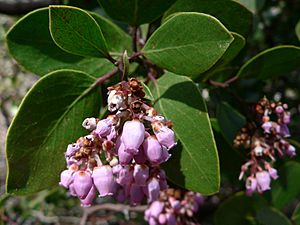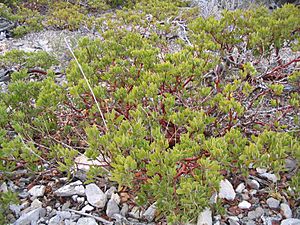Arctostaphylos facts for kids
Quick facts for kids Arctostaphylos |
|
|---|---|
 |
|
| Whiteleaf manzanita (Arctostaphylos viscida) | |
| Scientific classification |
|
| Kingdom: | Plantae |
| Clade: | Tracheophytes |
| Clade: | Angiosperms |
| Clade: | Eudicots |
| Clade: | Asterids |
| Order: | Ericales |
| Family: | Ericaceae |
| Subfamily: | Arbutoideae |
| Genus: | Arctostaphylos Adanson |
| Type species | |
| Arctostaphylos uva-ursi (Linnaeus) Sprengel
|
|
| Species | |
|
About 60, see text. |
|
Arctostaphylos is a group of plants that includes the well-known manzanitas and bearberries. The name Arctostaphylos comes from two ancient Greek words: "arktos" meaning "bear" and "staphyle" meaning "bunch of grapes." This name likely refers to bears eating the berries. These plants are usually shrubs or small trees.
There are about 60 different kinds of Arctostaphylos plants. They can be very small, growing close to the ground in cold or coastal areas, or they can be small trees up to 6 meters (about 20 feet) tall. Most of these plants are evergreen, meaning they keep their leaves all year round. They have small, oval-shaped leaves that are 1 to 7 centimeters long.
The flowers of Arctostaphylos plants look like little bells. They are usually white or light pink. These flowers grow in small groups of 2 to 20 together and bloom in the spring. After the flowers, small berries grow, which ripen in the summer or autumn. The berries of some Arctostaphylos species can be eaten.
Some types of Lepidoptera (like butterflies and moths) use Arctostaphylos plants as food. For example, the caterpillars of Coleophora arctostaphyli eat only the leaves of the common bearberry.
Contents
Where Arctostaphylos Plants Grow
Most Arctostaphylos species, especially the manzanitas, are found in western North America. They grow in areas like southern British Columbia in Canada, and in the United States from Washington down to California and New Mexico. You can also find them in many parts of northern and central Mexico. These areas often have a type of dry, shrubby landscape called chaparral.
Three special kinds of Arctostaphylos are called bearberries. These are the alpine bearberry (A. alpina), red bearberry (A. rubra), and common bearberry (A. uva-ursi). These bearberries are able to live in very cold, arctic and subarctic places. They are found all around the northern parts of North America, Asia, and Europe.
An interesting place where manzanitas grow is on Hood Mountain in Sonoma County, California. Here, you can find small "pygmy forests" where tiny Mendocino cypress trees grow alongside manzanitas.
Ancient Arctostaphylos Plants
Scientists have found very old fossil fruits of Arctostaphylos plants. These fossils, named †Arctostaphylos globula and †Arctostaphylos menzelii, were discovered in rocks from the middle Miocene period in Denmark. This shows that these plants have been around for a very long time!
Growing Arctostaphylos Plants
Growing Arctostaphylos plants in gardens can be quite tricky. They often get sick from fungal diseases. Also, they don't like soil that is too salty or too alkaline (the opposite of acidic). It's best to avoid watering them from above when the weather is hot. However, some special types of Arctostaphylos that have been bred for gardens are a bit easier to grow.
How Scientists Classify Arctostaphylos
Scientists group Arctostaphylos plants into different categories to understand their relationships. According to experts like Philip V. Wells, there are two main groups, called subgenera:
- Subgenus Micrococcus
- This group includes plants like:
- Arctostaphylos mendocinoensis (Pygmy manzanita)
- Arctostaphylos myrtifolia (Ione manzanita)
- This group includes plants like:
- Subgenus Arctostaphylos
- This larger group is divided into three sections:
- Sect. Arctostaphylos
- This section includes many well-known types such as:
- Sect. Arctostaphylos
- This larger group is divided into three sections:
* Arctostaphylos alpina (Alpine bearberry) * Arctostaphylos bakeri (Baker's manzanita) * Arctostaphylos densiflora (Sonoma manzanita) * Arctostaphylos franciscana (Franciscan manzanita) * Arctostaphylos glauca (Bigberry manzanita) * Arctostaphylos hookeri (Hooker's manzanita) * Arctostaphylos insularis (Island manzanita) * Arctostaphylos manzanita (Common manzanita) * Arctostaphylos nevadensis (Pinemat manzanita) * Arctostaphylos patula (Greenleaf manzanita) * Arctostaphylos pungens (Pointleaf manzanita) * Arctostaphylos uva-ursi (Bearberry) * Arctostaphylos viscida (Sticky manzanita)
-
-
- Sect. Foliobracteata
- This section has many manzanita species, including:
- Sect. Foliobracteata
-
* Arctostaphylos andersonii (Santa Cruz manzanita) * Arctostaphylos auriculata (Mount Diablo manzanita) * Arctostaphylos columbiana (Hairy manzanita) * Arctostaphylos glandulosa (Eastwood manzanita) * Arctostaphylos hooveri (Hoover's manzanita) * Arctostaphylos montereyensis (Monterey manzanita) * Arctostaphylos morroensis (Morro manzanita) * Arctostaphylos pallida (Pallid manzanita) * Arctostaphylos tomentosa (Woolyleaf manzanita)
-
-
- Sect. Pictobracteata
- This section includes:
- Sect. Pictobracteata
-
* Arctostaphylos pringlei (Pringle manzanita)
Some other Arctostaphylos species are still being studied to figure out exactly where they fit in these groups. For example, Arctostaphylos rainbowensis and Arctostaphylos gabilanensis.
Sometimes, plants that were once thought to be Arctostaphylos are now placed in other groups. For example, Arctostaphylos bicolor is now usually called Xylococcus bicolor. Also, Arctostaphylos crustacea is now considered a type of Arctostaphylos tomentosa.
There is also a plant group called Comarostaphylis which is very similar to Arctostaphylos.
Images for kids
-
Common bearberry Arctostaphylos uva-ursi
See also
 In Spanish: Arctostaphylos para niños
In Spanish: Arctostaphylos para niños




